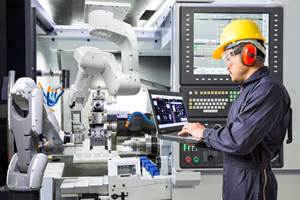Buying a Lathe: Slant-Beds and Multitasking Configurations
What are some variations on the basic lathe configuration? This can be helpful to review when considering the purchase of a new turning machine.
Share





When buying a turning machine, it can be helpful to be familiar with the various machine configurations available. Slant-bed lathes provide a number of advantages, while multitasking lathe configurations might open up possibilities heretofore unthought of.
Slant-Bed Lathes
The slant-bed lathe design is probably the most common and well-known configuration in today’s CNC lathes. Typically, the bed of the lathe slants at a 30- or 45-degree angle, although some 60-degree models also are available.
One obvious advantage to the slant-bed design is effective chip evacuation. Chips are simply washed into a chip conveyor or tray in the machine by the flow of coolant and the assistance of gravity. In high-volume production environments, evacuating chips quickly helps prolong the life of the machine by preventing them from accumulating where they may wear the machine ways or other moving parts.
Another advantage of slant-bed designs is larger X-axis travel. Unlike flatbed lathes in which the length of the guide rail is limited to the horizontal depth of the casting, the slant-bed design accommodates longer X-axis rails. This design also enables the slant-bed lathe to accept a larger part than a flatbed lathe with the same footprint.
Optimally, the headstock of a slant-bed lathe is mounted on the bed and shares the same 30- or 45-degree angle, parallel to the X axis and traveling on the same plane as the linear axes. Less-expensive models may be constructed with the base of the headstock at zero degrees (flat on the base and not slanted). This design makes the machine harder to get back in operation after a crash.
Multitasking Lathes
Multitasking machines are often built on a turning center platform. These machines use rotary tools to combine several cutting processes such as turning, milling, drilling, tapping, grooving, threading and deep-hole boring on one machine. It is not necessary to have multiple machines to handle those operations separately. Typically, multitasking turning centers have a second main spindle or an additional subspindle to which the workpiece can be transferred automatically from the first spindle. This enables continuous and simultaneous machining of first and second operations. The second spindle can grab the part for work on its back side to complete the part in one setup.
When a subspindle is used in conjunction with a bar feeder, the subspindle grabs the end of the bar and pulls out the length needed for the next part. The subspindle is more precise in pulling out the stock than the bar feeder is pushing it in.
After the parting tool severs the finished part, the subspindle can then drop it into the parts catcher while the main spindle begins machining the next part. The value of the parts catcher cannot be overstated as a reliable method for removing the finished part from the subspindle to make room for the next part.
With automatic subspindle workpiece transfer, a three-jaw or dead-length collet chuck is required. You don’t want a chuck or collet that may move in or out slightly to push or pull on the workpiece when clamping. This unwanted motion can easily mar the workpiece.
There’s virtually no limit to the variety of multitasking lathes that provide innovative part-processing combinations and superb performance. Twin main spindles and dual-turret configurations are two examples. It should be noted that it may be necessary to have separate part programs that can run simultaneously, each synchronized to avoid a collision. Shops that are new to the concept of multitasking on a lathe may not realize that new programming software and additional programmer training may be required to support these machines.
This is part four of a four-part series about buying turning machines.
- Part one: Buying a Lathe: The Basics
- Part two: Buying a Lathe: Turrets and Live Tooling
- Part three: Spindles and Tailstocks
Find more insights about acquiring a new machining center by visiting the Techspex Knowledge Center, “.”
Related Content
How to Meet Aerospace’s Material Challenges and More at IMTS
Succeeding in aerospace manufacturing requires high-performing processes paired with high-performance machine tools. IMTS can help you find both.
Read More6 Machine Shop Essentials to Stay Competitive
If you want to streamline production and be competitive in the industry, you will need far more than a standard three-axis CNC mill or two-axis CNC lathe and a few measuring tools.
Read MoreHow to Determine the Currently Active Work Offset Number
Determining the currently active work offset number is practical when the program zero point is changing between workpieces in a production run.
Read More2 Secondary Coordinate Systems You Should Know
Coordinate systems tell a CNC machine where to position the cutting tool during the program’s execution for any purpose that requires the cutting tool to move.
Read MoreRead Next
How I Made It: Dennis Rymanowski
Dennis Rymanowski has worked at NSH USA for 60 years, with his passion for manufacturing living alongside his passion for his family’s polka band.
Read MoreA New Frontier in Surface Finish Control
What if your machine tool could measure surface roughness as it cuts? This article explores how in-process metrology is advancing from concept to reality, enabling real-time feedback, immediate detection of anomalies and new levels of control over surface quality. Discover the technologies making this possible.
Read More





















